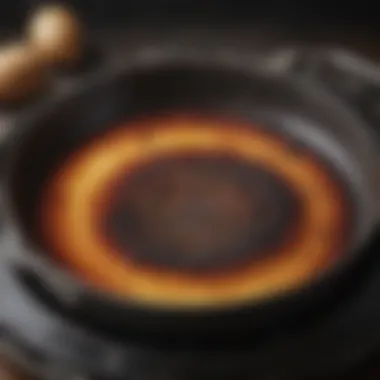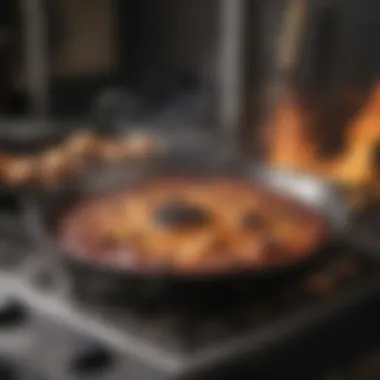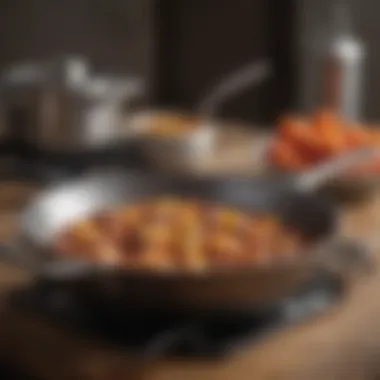Restore Your Cookware: Clean a Burned Pan Easily


Intro
Cleaning a burned pan is a task often met with frustration. Pans are essential kitchen tools, and their maintenance is crucial for both functionality and aesthetics. When food gets scorched, it can seem as if the pan is beyond saving. However, there are effective methods and techniques available to restore it to its former glory. This guide aims to offer a systematic approach to tackling burned pans, drawing on practical advice that utilizes common household items along with specialized cleaning products. Understanding the cleaning process not only helps recover the pan, but also ensures longevity in your cookware.
Through this article, readers will learn about diverse strategies, from abrasive scrubbing methods to gentle natural solutions. Each method comes with its own set of tools and ingredients, which are easily accessible and straightforward to deploy. Armed with this knowledge, anyone can confidently clean their burned pans without the stress of ruining them further.
Importance of Knowing How to Clean Burned Pans
Being proficient in cleaning burned pans extends beyond mere aesthetics. Proper maintenance of cookware can enhance cooking performance, contributing to better meals. Furthermore, many cleaning techniques can help prevent future burning, allowing for enjoyable cooking experiences. In an age where sustainability is increasingly valued, knowing how to restore rather than replace pans aligns with environmentally conscious practices.
Understanding the Problem
Cleaning a burned pan is a common issue that many encounter in the kitchen. It is crucial to understand the problem before attempting to resolve it. First, recognizing the type of material your pan is made from can influence the cleaning method you choose. For instance, stainless steel, cast iron, and non-stick materials all require different approaches.
Additionally, understanding why pans often get burned can help in preventing similar occurrences in the future. Knowing the causes can guide one to adopt better cooking practices, which can prolong the lifespan of cookware. By exploring the importance of the problem, this article provides insights that allow you to restore your pans effectively while minimizing damage.
Types of Pans Prone to Burning
Certain pans are more likely to suffer from burns compared to others. The following types frequently experience burning:
- Stainless Steel Pans: They are durable but can easily scorch if left unattended or heated too high.
- Non-stick Cookware: While designed to prevent sticking, certain temperatures can damage the coating and cause food to burn onto the surface.
- Cast Iron Pans: They retain heat exceptionally well, which can lead to burning if food is not monitored closely.
- Copper Pans: Although they heat evenly, excessive heat can cause food to stick and burn.
Certain care and attention can save these pans from the more severe effects of burning.
Common Causes of Burned Pans
When addressing a burned pan, it is vital to identify what led to the issue in the first place. Common causes include:
- High Heat: Cooking at excessively high temperatures can result in food sticking to the pan's surface.
- Overheating When Empty: Heating an empty pan can result in it reaching a temperature that quickly char foods.
- Cooking for Extended Periods: Leaving food unattended for long periods can allow sticking and burning to occur.
- Improper Cleaning Methods: Using abrasive materials on pans can damage their coating, leading to food sticking and burning.
Understanding these factors can assist in adopting practices that mitigate the likelihood of reoccuring burning, thus ensuring the longevity of your pans.
Initial Assessment of Damage
Understanding the condition of a burned pan is essential before moving on to cleaning methods. Evaluating the severity of the burn and determining the pan's material can greatly influence the choice of technique and cleaning products. Ignoring these two aspects might lead to ineffective cleaning attempts or, in the worst cases, damage to the cookware itself.
Determining the Severity of Burn
Assessing how badly a pan is burned is an important first step. The severity can range from light discoloration to deep charring. Here are some indicators of severity:
- Light Burn: Usually just requires soaking in warm, soapy water. Surface discoloration is apparent but not excessive.
- Medium Burn: May have some stubborn stains and a harder charred layer. Soaking alone may not be enough.
- Heavy Burn: This type is marked by deep blackened areas and can sometimes compromise the pan's structure. It might need advanced cleaning methods.
Taking the time to evaluate the burn's extent allows for the adoption of the appropriate cleaning method. For instance, medium and heavy burns may respond better to stronger solutions or scrubbing techniques.


Identifying the Material of the Pan
The material of the pan significantly influences both its cleaning process and the products that should be used. Common cookware materials include:
- Stainless Steel: Known for its durability. It can handle abrasive cleaners, though care should still be taken to prevent scratching.
- Non-stick Cookware: Requires gentle cleaning methods to avoid damage. Harsh scrubbing or strong chemicals can ruin its coating.
- Cast Iron: This material is unique. While it can often withstand tough cleaning, it requires specific care to maintain its seasoning.
Identifying the material allows for tailored cleaning strategies, helping avoid methods that could potentially harm the pan. Always look for care instructions specific to the cookware brand for the best results.
"Understanding the type of burn and material can save time and preserve cookware integrity."
By focusing on the damage assessment, you set the stage for an effective cleaning approach tailored to the specific needs of your burned pan.
Basic Cleaning Techniques
Basic cleaning techniques are fundamental when addressing the issue of burned pans. These methods not only offer an immediate solution but also prevent further damage to the cookware. The importance lies in the ease and accessibility of these techniques, as many utilize common household items. Understanding how to approach the cleaning process can simplify the task and restore the functionality of the pan.
Soaking the Pan
Soaking the burned pan in warm water is one of the most effective initial methods. This process helps to loosen food residues and charred remnants, making them easier to remove. To ensure optimal results:
- Fill the pan with warm water.
- Let it sit for 15 to 30 minutes, depending on the severity of the burn.
- Gently scrub the surface with a non-abrasive sponge after soaking.
By allowing the pan to soak, you reduce the physical effort needed later in the cleaning process. This method is particularly useful for larger pans where scrubbing could cause fatigue or damage.
Using Baking Soda
Baking soda serves as a mild abrasive that effectively tackles stubborn stains and burnt residues. Its alkaline properties help break down greasy substances. Following this method involves:
- Sprinkling baking soda over the burned areas of the pan.
- Adding a small amount of water to form a paste.
- Letting the mixture sit for approximately 15 minutes.
- Scrubbing the pan gently with a sponge or cloth.
This technique is beneficial for stainless steel and induction pans, although care must be taken with non-stick surfaces to prevent scratches. The versatility of baking soda makes it a staple in many kitchens with an array of cleaning applications.
Employing Dish Soap and Water
Combining dish soap with warm water creates an effective cleaning solution for most burns. Dish soap cuts grease and helps lift food particles from the pan's surface. To utilize this method:
- Fill the pan with warm water and add a few drops of dish soap.
- Allow it to soak for 15 to 20 minutes.
- Carefully scrub with a non-abrasive sponge.
This method works well for pans that have burnt on food but have not experienced severe charring. It's vital to rinse the pan thoroughly after cleaning to ensure no residue from the soap is left behind. This technique can often restore the pan to a usable condition without causing any harm.
Advanced Cleaning Methods
When it comes to restoring a burned pan, advanced cleaning methods serve as vital tools in tackling stubborn stains and residues that basic techniques may not fully address. These methods often utilize specific chemical interactions or targeted ingredients that effectively penetrate and lift away burnt food particles. By understanding these advanced techniques, one can not only save their cookware but also enhance its longevity and performance.


Vinegar and Baking Soda Technique
The combination of vinegar and baking soda is a time-honored method for many cleaning tasks, but it is particularly effective for burned pans. The acidity of vinegar helps to cut through the burnt-on grime, while the alkalinity of baking soda acts as a gentle abrasive. When combined, they react and release carbon dioxide bubbles, which can help dislodge tough food residues.
To use this technique, start by sprinkling a generous layer of baking soda over the burned areas of the pan. Next, pour white vinegar over the baking soda. Allow the mixture to fizz and react for several minutes. After this, scrub the pan gently with a soft sponge or cloth. Rinse and see the remarkable difference.
Using Hydrogen Peroxide
Hydrogen peroxide is an excellent agent for cleaning burned pans, particularly for those with significant discoloration. It has strong oxidizing properties, which can break down stubborn stains and burnt-on residues effectively.
To employ this method, pour hydrogen peroxide directly onto the burned areas of the pan. Let it sit for about 30 minutes to allow it to penetrate the stains. Once the time has passed, use a non-abrasive scrubber to gently scrub the affected areas. Rinse the pan thoroughly afterward. This method is particularly suitable for stainless steel and glass pans, but caution should be exercised with non-stick surfaces.
Commercially Available Cleaners
For those who prefer ready-made solutions, there are various commercially available cleaners designed to tackle burnt cookware. Many brands such as Bar Keepers Friend and Goo Gone offer formulations specifically designed for kitchenware. These products often include strong chemical agents that can breakdown burned residues effectively.
When using these cleaners, it is crucial to follow the manufacturer's instructions to avoid damaging the cookware. Most products require you to apply the cleaner, let it sit for a specified amount of time, and then scrub before rinsing. While effective, it is wise to assess if such products are necessary before opting for them, as many household items can achieve similar results.
Always remember to ventilate your kitchen properly when using strong chemical cleaners to ensure safety.
Specific Materials and Their Care
Understanding how to clean a burned pan effectively is paramount, but knowing how to care for various materials is equally important. Every type of cookware has its unique characteristics and vulnerabilities. By tailoring cleaning methods to specific materials, one can extend the lifespan of the cookware and maintain its performance and appearance. This section discusses the care needed for three common types of pans: stainless steel, non-stick cookware, and cast iron pans.
Stainless Steel Pans
Stainless steel pans are favored for their durability and resistance to rust and corrosion. They are excellent for browning and sautéing. However, they can be prone to burn stains, especially when used on high heat for extended periods. To clean burned stains from stainless steel, it is vital to avoid scouring pads that can scratch the surface.
A simple yet effective method is to sprinkle some baking soda over the burned areas, add water to form a paste, and let it sit for a few minutes. Following that, employ a soft sponge or cloth to scrub gently. For tougher stains, a vinegar rinse can help restore shine.
Non-stick Cookware
Non-stick cookware provides a smooth surface that requires less oil for cooking, making it a popular choice among food lovers. However, improper care can lead to damage and reduced effectiveness. Use only silicone or wooden utensils to prevent scratching the coating. For cleaning, hand washing with warm soapy water is recommended, as dishwashers can cause wear.
If the coating has stains, a mix of baking soda and water can be effective. Apply the paste to the affected areas, let it sit, then gently scrub with a non-abrasive sponge. Be cautious with high heat; overheating non-stick pans can release harmful gases.
Cast Iron Pans
Cast iron pans are treasured for their excellent heat retention and natural non-stick properties when properly seasoned. However, they can develop rust and burned residue if not maintained correctly. After each use, it is best to rinse with warm water and a brush, avoiding soap that can strip the seasoning.
For burnt food, soak the pan in water for a short time and use a scraper to detach the residue. In severe cases, a salt scrub can help remove stubborn stains. After cleaning, always dry the pan thoroughly and apply a thin layer of oil to protect it from moisture.
Regular maintenance of cast iron cookware is essential for optimal performance and longevity.


In summary, understanding material-specific techniques is crucial for maintaining cookware in good condition. Each type of pan requires different approaches to prevent damage and ensure effective cleaning. By following these care guidelines, food lovers can keep their cookware functioning well for years.
Preventing Future Burns
Preventing future burns on your cookware is crucial for maintaining not just the appearance of your pans, but also their longevity. Burn marks can damage the surface of the pan, making it harder to clean and potentially affecting the quality of your cooking. By implementing effective strategies, you can ensure that your pans stay in good condition and enhance your culinary experience.
Proper Cooking Techniques
It is vital to employ proper cooking techniques to minimize the risk of burning your pans. Here are some critical practices that can help:
- Monitor Food Closely: Stay attentive while cooking, especially with items that are prone to burn quickly.
- Use Enough Oil or Fat: Ensuring the cooking surface has adequate oil can reduce sticking and burning.
- Avoid Premature Transfers: Allow food to develop a crust before attempting to move it. This can help prevent tearing and unwanted sticking.
- Use the Right Utensils: Avoid metal utensils on non-stick surfaces; choose wood or silicone instead. This prevents damaging the coating and reduces chances of burning.
These actions help minimize not only burns but also enhance the flavor and texture of your dishes.
Choosing the Right Heat Settings
Understanding how to effectively use heat settings is crucial in preventing burned pans. Here are insights about heat management:
- Preheat Gradually: Instead of cranking the heat high from the start, preheat slowly. This allows an even temperature distribution.
- Know Your Cookware: Different materials retain heat differently. For example, cast iron pans require lower heat settings than stainless steel.
- Use a Heat Diffuser: When cooking over high heat, consider using a heat diffuser. This helps distribute the heat evenly and prevents hot spots that can lead to burns.
Correct heat management enhances cooking, allowing for better results while protecting your pans.
Maintaining Cookware
Regular maintenance of your cookware reduces the likelihood of burns occurring in the first place. Here are techniques to consider:
- Regular Cleaning: Clean pans after each use to avoid build-up that can lead to burning. Residue can char and create smokey flavors in future meals.
- Season Cast Iron: For cast iron pans, seasoning them appropriately with oil helps create a non-stick surface that enhances cooking and reduces burns.
- Inspection for Damage: Routinely check your pans for scratches or worn spots. Addressing these issues early maintains the functionality of the cookware.
By focusing on these aspects of cookware maintenance, you can prolong the life of your pans and reduce the likelihood of future burns.
Tip: Proper care and cooking techniques can turn your pans into dependable tools that last for years.
Ending
Cleaning a burned pan is more than just a task; it is an essential skill for anyone who enjoys cooking. The importance of mastering effective cleaning methods cannot be overstated. It saves time, reduces stress, and extends the life of cookware, making it a worthwhile endeavor.
Recap of Effective Cleaning Methods
In summary, several effective cleaning methods can restore a burned pan. Here are the key techniques discussed throughout this article:
- Soaking the pan: Allowing burnt residue to dissolve will make it easier to scrub.
- Using baking soda: This common household item is effective for lifting stubborn stains.
- Employing dish soap and water: The basic combination can often yield satisfactory results.
- Vinegar and baking soda: This powerful duo works well for tougher burns.
- Hydrogen peroxide: A strong cleaner suitable for various types of stains.
- Commercially available cleaners: Products are designed specifically for heavy-duty cleaning.
Knowing when and how to apply these methods will help you maintain your cookware, ensuring it remains in good condition.
Final Thoughts on Cookware Care
Cookware care is a crucial component of kitchen management. Proper maintenance not only preserves functionality but also enhances the cooking experience. Careful practices include choosing correct heat settings and using proper cooking techniques. This proactive approach will minimize the chances of burns, saving you from the headache of future cleaning challenges. Remember, a well-maintained pan not only performs better but also contributes to a more enjoyable cooking process.
"An ounce of prevention is worth a pound of cure." This adage applies well to cookware; taking time to observe proper techniques can pay off significantly in the long run.







